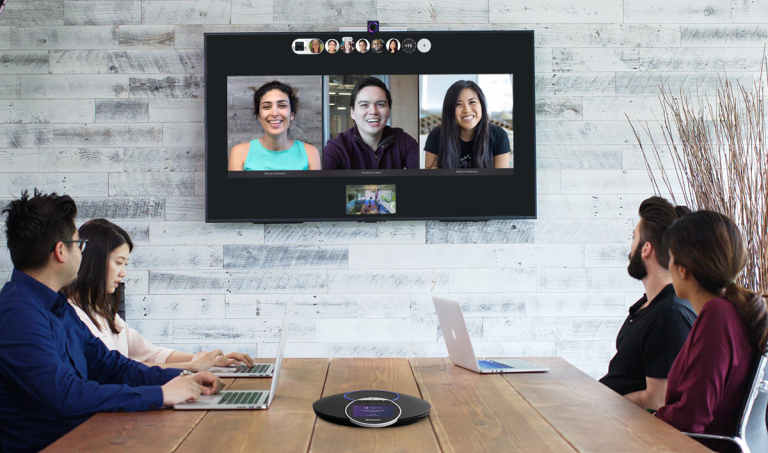Web conferencing is a really essential tool today for collaborating with colleagues and clients alike. A range of features, from the basic ones to the more advanced variants, exist to further improve the experience of these online meetings. But as the features increase, so does the price. For small businesses and startups, it is not really feasible to use a high-end web conferencing tool to hold meetings. At the same time, picking up any run-of-the-mill conferencing tool wouldn’t work either. So, to simplify things for you, here are 10 web conferencing tools that would prove really cost-effective for your team:
1. Zoom
Without much doubt, the most popular web conferencing tool among professionals is Zoom. The software, which features in almost every “best web conferencing tool” list, has more than earned its reputation. Zoom comes in both free and paid plans. The Free plan gives you a decent start, with up to 3 participants but one host in a meeting. The duration can be up to 40 minutes. Other features include 720p HD video, personal rooms, recording on a local device, and support for all major OS and SSL encryption.
The paid plans start from $14.99/month/host. Each host can include 100-1000 participants, depending on the plan. Advanced features include cloud recording, company branding, custom emails, admin control and unlimited cloud storage. The paid plan of Zoom is actually among the cheapest of all paid web conferencing tools. However, the free plan gets most of the things done if you are not willing to spend money right now. Interestingly, participants in a meeting don’t need to have a Zoom account to take part in the meeting.
2. Cisco WebEx
Another name that instantly pops up when talking about professional web conferencing tools is Cisco WebEx. Part of the famed Cisco series of networking solutions, WebEx was first founded in 1995 – among the first tools for web conferencing. But its simplicity and constant innovation have allowed it to remain one of the best tools at your disposal, almost 25 years later.
Cisco WebEx comes in both free and paid versions. The free version offers much the same functionality as any other free version: up to 3 participants, screen sharing, screen recording etc. WebEx offers swift integration with Spark. This is a very important feature, as Spark offers great security protocols and encryption to WebEx. In simple words, security is the primary attraction of WebEx. WebEx could be used over a variety of devices (smartphones, tablets, desktops, laptops) and operating systems (Android, iOS, Mac, Linux). It also comes with built-in integration capabilities for other utility applications like Outlook, Google, Office 365 etc. There are many more features WebEx can offer, but they are hidden behind a paywall. The paid plans of WebEx usually fall towards the higher side of things (compared to other tools), but they are also worth the money.
3. Skype For Business
Everyone has heard of Skype, even those who have no interest in web conferencing. One of the most popular applications for video calling, Skype can be extended for other uses as well. The biggest USP of Skype is that it is completely free. Apart from advanced voice calling, all features are completely free for all users. For small teams, Skype offers a good option for web conferencing. There are basic features like screen sharing and file transfer, while up to 25 participants can be added in a meeting. Being a general-purpose app, Skype is compatible with almost all major devices and operating systems.
Skype For Business (Skype B, for short) is the enterprise variant of the tool from Microsoft. It specifically focuses on the needs of large organizations, as evident from the fact that it can add up to 250 participants in a meeting. The Broadcast feature allows additional 10,000 people to view the meeting. Skype B offers greater integration with other Microsoft applications like Office 365. It also has better security features like AES encryption, admin master control, fixed login attempts etc. Skype B is a paid application, but the plans start from as low as $2/month/user.
4. GoToMeeting
Another popular name, GoToMeeting is a very common tool used by professionals to host conference calls. The main idea of the application lies in its sheer ease of use. GoToMeeting can be used virtually everywhere. Apart from the support on various devices and on various operating systems, the application can also be used in a web browser. It comes with excellent integration with other utility apps too. This means that not only can you launch GoToMeeting from its dedicated app, but also from browsers or utility apps like mails. However, the free version of GoToMeeting is limited to audio conferencing only.
The paid plan of the application turns it into video conferencing software, adding a lot more features. It allows synchronous editing, cooperative writing, project management, up to six HD video feeds per session etc. GoToMeeting is a perfect web conferencing software for those who want maximum team collaboration during meetings. However, its price falls on a bit higher side compared to other tools.
5. Workplace by Facebook
Most people tend to sleep on Workplace, but this offering from Facebook can actually prove to be a great asset for web conferencing. The standard version of the tool is free, while the paid version ranges between $4-$8/month/user. As far as the features are concerned, there is literally a huge list of what it offers.
Workplace employs the power of Facebook, thus enabling a huge two-way communication network. It can cover not only the entire organization but even facilitate communication beyond it. Workplace is a great collaboration tool, facilitating easy communication and group discussions. Other features include screen sharing, private chat sessions, presentation streaming, recording video/audio and on-demand webcasting. Communication-specific features include knowledge management, A/V conferencing, newsletters and newsfeed. Brainstorming and group discussions can be highly interactive, ranging from simple chats to video collaborations. Workplace can actually be a powerful tool when you consider the huge network that Facebook facilitates for it. The tool can also be used in collaboration with other business tools; the integration only making its features more powerful. For small teams and/or teams that don’t require huge collaboration features, even the free plan works just fine.
6. Uberconference
If your team meetings are usually done on calls, then Uberconference is the perfect tool for you. The free web conferencing tool specialized in audio call conferences. It can add up to 10 participants per call while you get unlimited conference calls per month. Additional features include call recording and support for international conferencing numbers. The tool is pretty easy to use and usually does not require any credentials (on phone) to join the conference call. The audio is in HD quality and VoIP is also supported. All of this comes completely free of cost.
The paid version of the tool costs $10/line/month. It might be higher than usual, but a vast array of features comes with it to make the price worth it. International access is extended to 50 countries while a team management portal is provided. You can now add up to 100 participants per conference call and even upload your own custom hold music. At a small fee, you can also have your own custom toll-free number. However, apart from video conferencing software, most of these features are usually targeted for larger organizations. For small business and startups, the free version should be enough for the conferencing needs.
7. AnyMeeting
For those looking for getting the best from a free solution, AnyMeeting is pretty much the ultimate web conferencing tool for you. To begin with, it is a web-based app. So no downloads are required on any end to use the app, which speaks a lot about its simplicity. It offers standard features VoIP/phone conferencing, file sharing and meeting recording. Screen sharing is supported, though the host would require installing a plugin in the browser. AnyMeeting allows up to 200 participants to join a conference session. Since it is completely free, there are occasional advertisements popping up – but never during meeting sessions. Overall, AnyMeeting is simply a great tool for those looking for a completely free web conferencing solution.
8. Mikogo
Another lesser-known but extremely useful web conferencing tool is Mikogo. In all honesty, Mikogo doesn’t impress much at first; the interface is quite plain and doesn’t inspire ease of access. However, once you get past that, a whole lot of features await. The usual features include audio/video conferencing with multiple participants, meeting recording, screen share and easy joining to the meeting. However, some interesting features make Mikogo stand out amidst the crowd. The tool allows for pausing screen sharing. Usually, if you want to stop screen sharing for a moment, you would have to end and then restart it later; not with Mikogo. This feature comes handy when you are doing something on the screen that you don’t want others to see – like entering login credentials. Another cool feature is allowing for switching between video qualities. This feature is pretty useful when you are running low on bandwidth but still need video conferencing software.
The free version of Mikogo only allows for a limited number of participants per meeting. For unlimited participants, you would need a paid version. However, even the paid version is quite cheap, making it a cost effective video conferencing choice for small businesses.
9. TeamViewer
To be fair, Teamviewer is a team collaboration tool, aimed for things much more comprehensive than web conferencing. But web conferencing is, without a doubt, one of the things the tool can facilitate easily. As you would be aware, Teamviewer is one of the most popular professional collaboration tools in the market – so much that the company claims to have 1.3 billion+ devices connected to it.
So, what are the features you should be looking out for? Teamviewer supports all major devices and OS and boasts of a great customer support service. It offers document management, screen sharing, remote control and cooperative writing. Chat features are quite powerful, including offline texting, group messaging, sticky chats, and customer-centric chats and quick access to chat history. Security is a strong suite of Teamviewer and covers all devices. The app is specially optimized for mobile use. There is cloud support so that access to personal data is easier and more convenient. Another interesting feature is the QuickJon, which allows participants to join a meeting without installing the tool or signing up for it.
The best thing about Teamviewer is its scalability. Apart from the 30+ languages it supports, the tool can be used by anyone: from a very small group to a large organization. Teamviewer is primarily free, but the paid version too offers a free trial. Overall it is a really cost effective video conferencing tool.
10. Google Meet
The professional upgrade of Hangouts, Google Meet is another tool people usually sleep upon – so much so that many people haven’t even heard about this Google product. But Meet is really a great tool to have, especially if you are looking for a cost-effective solution.
The tool is supported by Android and iOS devices, as well as browser support for Chrome and Firefox. Launching a meeting is pretty easy; apart from the app and browser, you can also launch a meeting from Google Calendar or directly via link. Dial-up meetings are supported for US numbers, but incoming requests could come from almost all countries. Other features include high-resolution content, pinch-to-zoom (on mobile), partial or full-screen sharing, and easy join via a shared link. The standard, free version allows up to 25 participants. Paid plans can support up to 100 participants and also allow recording of meetings. The biggest USP of Meet is its simplicity to use. It can be used by anyone with a basic Google account (which is pretty much everyone in the professional world). The tool is light-weight and easily accessible on all platforms. On the web and mobile app, chat during conferencing is also supported.
Each of these tools offers some unique features and varies in their prices – from completely free to freemium and paid. Depending on your needs and budget, you are sure to find something that serves your purpose and offers a good experience.






